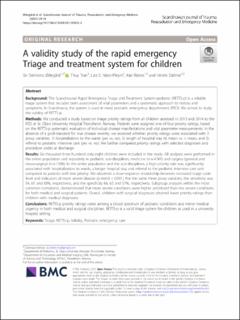| dc.description.abstract | Background: The Scandinavian Rapid Emergency Triage and Treatment System-pediatric (RETTS-p) is a reliable triage system that includes both assessment of vital parameters and a systematic approach to history and symptoms. In Scandinavia, the system is used in most pediatric emergency departments (PED). We aimed to study the validity of RETTS-p. Methods: We conducted a study based on triage priority ratings from all children assessed in 2013 and 2014 to the PED at St. Olavs University Hospital Trondheim, Norway. Patients were assigned one of four priority ratings, based on the RETTS-p systematic evaluation of individual disease manifestations and vital parameter measurements. In the absence of a gold-standard for true disease severity, we assessed whether priority ratings were associated with 3 proxy variables: 1) hospitalization to the wards (yes vs. no), 2) length of hospital stay (≤ mean vs. > mean, and 3) referral to pediatric intensive care (yes vs. no). We further compared priority ratings with selected diagnoses and procedure codes at discharge. Results: Six thousand three hundred sixty-eight children were included in the study. All analyses were performed in the entire population and separately in pediatric sub-disciplines, medicine (n = 4741) and surgery (general and neurosurgery) (n = 1306). In the entire population and the sub-disciplines, a high priority rate was significantly associated with hospitalization to wards, a longer hospital stay and referral to the pediatric intensive care unit compared to patients with low priority. We observed a dose-response relationship between increased triage code level and indicators of more severe disease (p-trend < 0.001). For the same three proxy variables, the sensitivity was 54, 61 and 83%, respectively, and the specificity 66, 62 and 57%, respectively. Subgroup analyzes within the most common complaints, demonstrated that more severe conditions were higher prioritized than less severe conditions for both medical and surgical patients. Overall, children with surgical diagnoses attained lower priority ratings than children with medical diagnoses. Conclusions: RETTS-p priority ratings varies among a broad spectrum of pediatric conditions and mirror medical urgency in both medical and surgical disciplines. RETTS-p is a valid triage system for children as used in a university hospital setting. | en_US |

